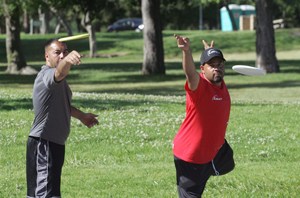
Fifteen years ago, Gilbert “Bamba” Rico was one of the world’s top-earning professional players of disc golf. That’s a sport with Frisbee-like discs taking the place of golf balls.
Even at the top of his game, though, Rico didn’t make much money. But now he believes his company, Legacy Discs in Chatsworth, will soon be bringing in enough cash so that he can quit his construction company.
Legacy manufactures special discs designed to provide long distance, flight stability and accuracy in throws. Since launching last year, the company has sold 60,000 discs although it hasn’t generated enough money to pay any salaries. So for now, Rico is still working half time at the family concrete construction company that funded the startup investment for Legacy.
“We had to pour a lot of concrete to make this venture take off,” he said. “We funded it on our own and now it’s self-sustaining.”
Disc golf started in the 1970s when teenagers began using Frisbees instead of balls to play on regular golf courses. As the sport grew, it dropped the name Frisbee golf because of Wham-O’s trademark. Also, players wanted specially designed flying discs. So companies such as Innova Champion Discs in Rancho Cucamonga and Discraft in Wixom, Mich., filled the demand and continue to dominate the market.
Today, serious players have “drivers” or heavy plastic discs that can be thrown 400 feet or more, midrange discs for 100- to 300-foot approach shots and “putters” for reaching a steel basket that is the equivalent of a hole in regular golf. The discs deteriorate with play as they hit trees, rocks and the steel baskets; the scuffs and dents affect their aerodynamics in flight.
Rico started playing 26 years ago, and at one point consistently won weekend tournaments. But he figures the best players in the world barely make $40,000 a year because as a niche sport, the tournament purses in disc golf amount to a few thousand dollars. Even during his professional heyday, Rico kept his construction gigs.
“It’s a lifelong passion to stay in the industry and make a living in it,” he said. “There is nothing I would rather do than make a disc and throw it.”
Legacy’s discs are designed by Rico and his younger brother Steve, also a pro player and partner in the company. The marketing strategy is to put their names on the discs, much like baseball equipment bears the names of famous players. The discs retail between $8 and $17 each.
Soaring goal?
Gilbert Rico’s said the company should reach breakeven selling 150,000 discs a year, but his goal is to sell a million annually.
“We didn’t do any market research, but we know the numbers,” he said. “We have both been sponsored by large manufacturers and we’ve seen their sales figures.”
The Professional Disc Golf Association in Appling, Ga., estimates that between 8 million and 12 million people have tried disc golf, and about 500,000 play regularly. There are now almost 3,000 courses in the United States, with about 12 in Los Angeles County, including one in Elysian Park overlooking Dodger Stadium. Other courses are in Sylmar, Long Beach, La Mirada and La Canada-Flintridge.
But for Legacy to sell 1 million units each year, that would mean every active player would have to buy two discs. Is that realistic?
Cliff Towne is president of Discsports in Southern California, a non-profit that runs after-school disc golf programs and organizes tournaments. He believes the million-disc goal is attainable. But for a new company to reach it, the sport itself needs to grow.
“There is plenty of room for new and smaller companies in the market, but it can be difficult to compete against economies of scale with the larger companies,” Towne said. “To get to the goal will require a growth path beyond where we are now.”
Vic Allen, a consultant with Disc Golf Consultants and Spring Valley Golf Course in Spring, Texas, said the shop at his course sells more than 10 brands of discs, with Innova and Discraft dominating.
“The main obstacle for Legacy is the companies already in the market,” he said. “To come into the market, even with a quality product, you’re not going to be a millionaire, but you’ll break even or make a little money. That’s where the sport is right now.”
But Legacy and its long-range models are popular, Allen said. He hopes the company succeeds because some of the mass manufacturers don’t have consistent quality in their product.
Rico said the company already has distribution in 300 stores nationwide, but its biggest sales channels are specialized websites for disc golfers. Also, he agreed that his company’s fortunes are tied to the expansion of disc golf.
“Our goal is to promote the sport,” he said. “If people discover the sport, that will obviously bring people to our company.”
Rico believes the key to Legacy’s growth is turning out new models of discs.
The company started with a single plastic-injection mold, which cost the brothers about $20,000. Discs manufactured with that mold generated enough profit to finance a second mold.
The company repeated the process and it now has five molds with more in the planning stages.
Rico has six family members who put in long hours at the Legacy warehouse, but none of them is paid.
He expects to hire employees soon – starting with himself – and get out of the construction business.
“It’s inevitable that this will become a full-time job,” he said. “I’ve promised the family that when Legacy Discs becomes overwhelming and has to take priority, it will.”
